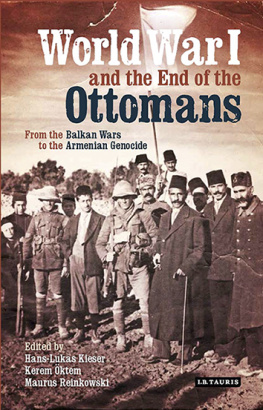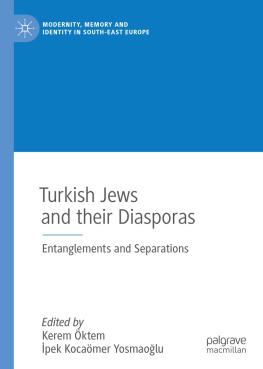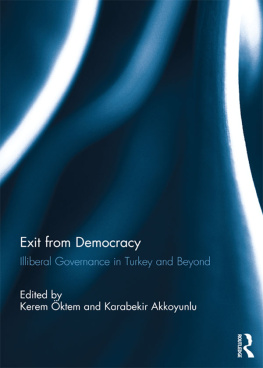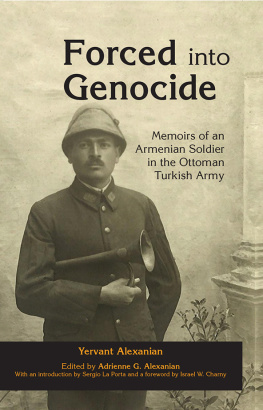Hans-Lukas Kieser, an historian of the late Ottoman and post-Ottoman world, is a fellow of the Australian Research Council at the Centre for the History of Violence in Newcastle NSW and a Professor of Modern History at the University of Zurich. He is Co-President of the Research Foundation Switzerland-Turkey.
Kerem ktem is Professor of Modern Turkey at the Centre for Southeast European Studies, University of Graz, and associate of the Centre for International Studies, University of Oxford. He is Co-President of the Research Foundation Switzerland-Turkey.
Maurus Reinkowski is an historian of the modern Middle East. He is Professor of Islamic and Middle Eastern Studies at the Department of Social Sciences, University of Basel, and at the present Visiting Professor at Sabanci University, Istanbul.
This is a very impressive collection. The authors have drawn on a wide variety of archival sources in many languages, too many to be mastered by a single scholar, including Arabic, Armenian, Hebrew, and Kurdish. Their research reveals links between events in the empire's distant regions, from Macedonia to eastern Anatolia to Palestine, from the battle front to the home front. The volume explores urgent questions concerning connections about war in the Middle East a century ago and war in the region today.
Mustafa Aksakal, Nesuhi Ertegun Chair of Modern Turkish
Studies and Associate Professor of History, Department of History,
Georgetown University
WORLD WAR I
AND THE END
OF THE
OTTOMANS
From the Balkan Wars to the
Armenian Genocide
Edited by H ANS -L UKAS K IESER , K EREM KTEM
AND M AURUS R EINKOWSKI
Published in 2015 by
I.B.Tauris & Co. Ltd
London New York
www.ibtauris.com
Copyright Editorial Selection and Introduction 2015 Hans-Lukas Kieser, Kerem ktem, Maurus Reinkowski
Copyright Individual Chapters 2015 Yiit Akn, Yuval Ben-Bassat, Hamit Bozarslan, Michelle U. Campos, Y. Doan etinkaya, Emre Erol, Hans-Lukas Kieser, Kerem ktem, Mehmet Polatel, Maurus Reinkowski, Thomas Schmutz, Vah Tachjian, Uur mit ngr
The right of Hans-Lukas Kieser, Kerem ktem, Maurus Reinkowski to be identified as the editors of this work has been asserted by the author in accordance with the Copyright, Designs and Patents Act 1988.
All rights reserved. Except for brief quotations in a review, this book, or any part thereof, may not be reproduced, stored in or introduced into a retrieval system, or transmitted, in any form or by any means, electronic, mechanical, photocopying, recording or otherwise, without the prior written permission of the publisher.
Every attempt has been made to gain permission for the use of the images in this book.
Any omissions will be rectified in future editions.
References to websites were correct at the time of writing.
Library of Ottoman Studies 53
ISBN: 978 1 78453 246 8
eISBN: 978 0 85772 947 7
A full CIP record for this book is available from the British Library
A full CIP record is available from the Library of Congress
Library of Congress Catalog Card Number: available
Supported by the Research Foundation Switzerland-Turkey

Supported by the Swiss National Science Foundation
Supported by the Australian Research Council
Supported by the Middle Eastern Studies at the University of Basel
Supported by the History Department at the University of Zurich
CONTENTS
Hans-Lukas Kieser, Kerem ktem, Maurus Reinkowski
Hans-Lukas Kieser
Yiit Akn
Y. Doan etinkaya
Emre Erol
Michelle U. Campos
Yuval Ben-Bassat
Mehmet Polatel
Thomas Schmutz
Vah Tachjian
Uur mit ngr
Hamit Bozarslan
LIST OF ILLUSTRATIONS AND TABLES
Illustrations
. Muslims who have been sent back to their villages from Kavala are attacked by a gang of irregulars. In Ahmed Cevad, Krmz Siyah Kitab: 1328 Fecayii (stanbul: 1329).
. The Ottoman soldiers who liberate Thrace from the enemy find a terrible massacre of Muslims. In Tccarzade brahim Hilmi, Trkiye Uyan (Dersaadet: Matbaa-i Hayriye ve rekas, 1329).
. A scene in which Muslims are stabbed with bayonets and thrown into the Vardar river. In Dr Cemil, Bulgar Vahetleri, ntikam, Evlad ve Ahfada Yadigar (Dersaadet, 1330), p. 122.
. Photograph of Muslim corpses lying on the ground. In Tccarzade brahim Hilmi, Trkiye Uyan (Dersaadet: Matbaa-i Hayriye ve rekas, 1329), p. 66 (the illustration also appeared in L'Illustration on 30 August 1913).
. A Muslim youth is tied to a stake behind his back in Kavala. In Dr Cemil, Bulgar Vahetleri, ntikam, Evlad ve Ahfada Yadigar (Dersaadet, 1330), p. 66.
. Postcards from the personal collection of Mehmet . Alkan.
. Bulgarians rushing into a mosque with their boots still on, killing old people at prayer with their rifles and bayonets. In Dr Cemil, Bulgar Vahetleri, ntikam, Evlad ve Ahfada Yadigar (Dersaadet, 1330), illustration no. 16.
. Forced ceremony of conversion. In Dr Cemil, Bulgar Vahetleri, ntikam, Evlad ve Ahfada Yadigar (Dersaadet, 1330), p. 79.
. Muslim women are shown nailed to crosses because of their refusal to convert to Christianity. In Dr Cemil, Bulgar Vahetleri, ntikam, Evlad ve Ahfada Yadigar (Dersaadet, 1330), p. 85.
. Three Muslim girls have been taken to a church for conversion to Christianity. In Ahmed Cevad, Krmz Siyah Kitab: 1328 Fecayii (stanbul, 1329).
. A child in the arms of her father or grandfather, probably wounded by the soldiers in Dedeaa. Behind them, three soldiers are chasing a Muslim away, while another takes a Muslim woman out of her house. In Ahmed Cevad, Krmz Siyah Kitab: 1328 Fecayii (stanbul, 1329).
. A soldier is cutting off the breasts of a Muslim woman, who is surrounded by an assaulting crowd of irregulars and soldiers in Kavala In Dr Cemil, Bulgar Vahetleri, ntikam, Evlad ve Ahfada Yadigar (Dersaadet, 1330), p. 81.
. Boulevard of Gallows. In Ahmed Cevad, Krmz Siyah Kitab: 1328 Fecayii (stanbul, 1329).
. A soldier is taking the unborn child out of a woman's body with his bayonet. In Dr Cemil, Bulgar Vahetleri, ntikam, Evlad ve Ahfada Yadigar (Dersaadet, 1330), p. 76.
Map
. Plain of Harput/Kharpert with its Armenian towns and villages
Table
. Land Clauses in Reform Plans
CONTRIBUTORS
Yiit Akn is Assistant Professor of History at Tulane University. His research interests include social and cultural history of the late Ottoman Empire and early Republican Turkey, with a particular focus on World War I, war and society, gender, nationalism, and social movements. He is the author of Robust and Vigorous Children: Physical Education and Sports in Early Republican Turkey (Istanbul: letiim Yaynlar, 2004). His research has been published in journals such as International Journal of Middle East Studies, International Review of Social History, and Journal of Womens History. Currently, he is finishing a monograph titled Experiencing Ottomans Great War: Everyday Politics, Society, and Culture. It examines the social and cultural dimensions of Ottoman societys catastrophic experience of World War I and analyzes the impact of the war on the empires civilian population.










